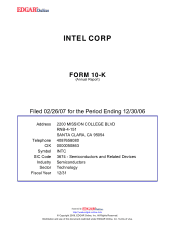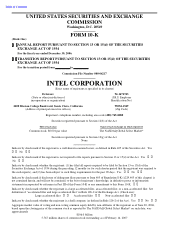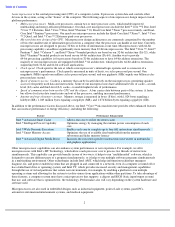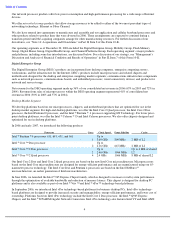Intel 2006 Annual Report Download - page 10
Download and view the complete annual report
Please find page 10 of the 2006 Intel annual report below. You can navigate through the pages in the report by either clicking on the pages listed below, or by using the keyword search tool below to find specific information within the annual report.
Table of Contents
Our network processor products offer low power consumption and high-performance processing for a wide range of Internet
devices.
We offer networked storage products that allow storage resources to be added to either of the two most prevalent types of
networking technology: Ethernet or Fibre Channel.
We also have entered into agreements to manufacture and assemble and test application and cellular baseband processors and
other products related to product lines that were divested in 2006. These arrangements are expected to continue during a
transition period until the acquiring companies arrange for other manufacturing resources. For further discussion of our
divestitures, see “Note 14: Acquisitions and Divestitures” in Part II, Item 8 of this Form 10-K.
Our operating segments as of December 30, 2006 included the Digital Enterprise Group, Mobility Group, Flash Memory
Group, Digital Home Group, Digital Health Group, and Channel Platforms Group. Each operating segment’s major products
and platforms, including some key introductions, are discussed below. For a discussion of our strategy, see “Management’s
Discussion and Analysis of Financial Condition and Results of Operations” in Part II, Item 7 of this Form 10-K.
Digital Enterprise Group
The Digital Enterprise Group (DEG)’s products are incorporated into desktop computers, enterprise computing servers,
workstations, and the infrastructure for the Internet. DEG’s products include microprocessors and related chipsets and
motherboards designed for the desktop and enterprise computing market segments; communications infrastructure components
such as network processors, communications boards, and embedded processors; wired connectivity devices; and products for
network and server storage.
Net revenue for the DEG operating segment made up 56% of our consolidated net revenue in 2006 (65% in 2005 and 72% in
2004). Revenue from sales of microprocessors within the DEG operating segment represented 41% of consolidated net
revenue in 2006 (50% in 2005 and 57% in 2004).
Desktop Market Segment
We develop platforms based on our microprocessors, chipsets, and motherboard products that are optimized for use in the
desktop market segment. For high-end desktop platforms, we offer the Intel Core 2 Quad processor, the Intel Core 2 Duo
processor, the Intel Pentium D processor, and the Intel
®
Pentium
®
4 processor supporting HT Technology. For lower price-
point desktop platforms, we offer the Intel
®
Celeron
®
D and Intel Celeron processors. We also offer chipsets designed and
optimized for use in desktop platforms.
In 2006 and early 2007, we introduced the following products:
Our Intel Core 2 Duo and Intel Core 2 Quad processors are based on the new Intel Core microarchitecture. Microprocessors
based on the Intel Core microarchitecture are designed for energy-efficient performance and are manufactured using our 65-
nanometer process technology. The Intel Core Duo and Pentium 4 processors are based on the Intel NetBurst
®
microarchitecture, an earlier generation of Intel microarchitecture.
In June 2006, we launched the Intel
®
965 Express Chipset family, which is designed to increase overall system performance
through the optimization of available bandwidth and reduction of memory latency. This chipset is designed for desktop PC
platforms and is also available as part of our Intel
®
Viiv
TM
and Intel
®
vPro
TM
technology-based platforms.
In September 2006, we introduced Intel vPro technology-based platforms for business desktop PCs. Intel vPro technology-
based platforms are designed to provide increased security and manageability, energy-efficient performance, and lower cost of
ownership. Platforms based on Intel vPro technology include the Intel Core 2 Duo processor, the Intel
®
Q965 Express
Chipset, and the Intel
®
82566DM Gigabit Network Connection. Intel vPro technology also features Intel VT and Intel AMT.
4
Processor
Cores
Clock Speed
Front Side Bus
Cache
Intel
®
Pentium
®
4 processors 631, 641, 651, and 661
1
Up to
3.60 GHz
800 MHz
2 MB of L2
Intel
®
Core
TM
Duo processor
2
Up to
2.16 GHz
667 MHz
2 MB of L2
Intel
®
Core
TM
2 Duo processor
2
Up to
2.66 GHz
1066 MHz
Up to 4 MB of shared
L2
Intel
®
Core
TM
2 Quad processor
4
2.4 GHz
1066 MHz
8 MB of shared L2























